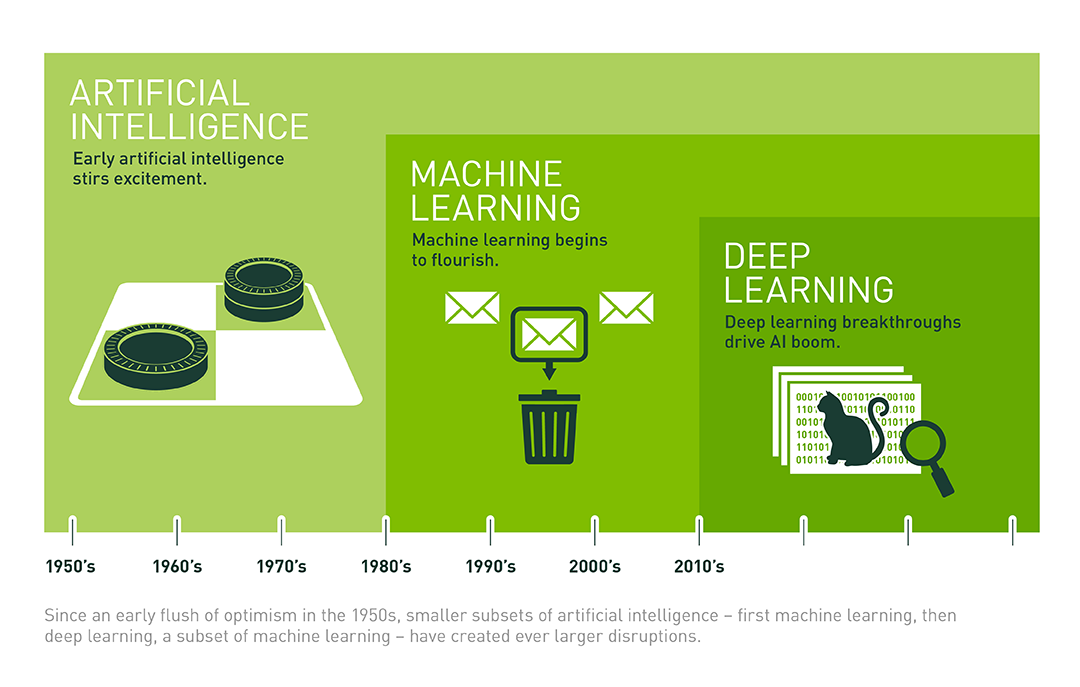Many may ask, what is machine learning (ML)? We have heard this buzzword very often in the media or by big-name tech companies and lately, it has been used interchangeably with the word “artificial intelligence” (AI). These days, it is ubiquitous to hear this:
“…the cameras on X smartphone is powered by an advanced AI that improves the image quality at night by 25.5%…”
The word machine learning/AI is overrated and used as a marketing strategy.
Going back to the title of this post, what is an Artificial intelligence and machine learning? An AI is the computer’s ability to make decisions without intervention of human (preset rules) and exhibit a “sort” of intelligence. Machine learning, on the other hand, is a set of computer instructions (algorithms or model) applied on a large scale of data (a large number of bits of information) also refer as big data and train on that data to come up with predictions that might occur in the future. As more and more data is generated each day online, it has become tough to get a sense of it using our human capacity. Therefore, we use an algorithm to understand the data and make predictions.
Applications
Machine learning is used in different areas ranging from health, robotics to even agriculture (YouTube video here), but as of the end of 2018, AI is mostly used in the recommendation system like the one on Amazon or Alibaba that uses recent viewed/purchased item to predict the next purchases.
Machine learning is also used in the self-driving car (YouTube video here) and face recognition used by Facebook (photo tagging) and Apple on their iPhone X. This kind of machine learning uses computer vision with pattern recognition to detect an object on the picture or in the surrounding. There is another kind of machine learning called natural language processing (NLP) that rely on speech recognition to translate input using the voice. An example of the application of NLP is Siri or Google voice assistant. These kinds of AI are called artificial narrow intelligence (ANI), which mean that these AI particularly excel at one single task and perform poorly in any other duty which they haven’t been trained on.
Last but not least, ML is used in the area of cyber-security and spam/malware filtering. In cyber-security, ML is used to detect fraud while transacting online. For example, Paypal is using ML to flag money laundering activities. ML is also used to filter spam from emails, that’s why these days you don’t see many of those anymore in your inbox.
These are the types of applications that come to my mind right now, but you should not assume that the application of ML is only limited to these. Areas such as GPS navigation to find the shortest route, search engine result refinement and many more are using ML.
Type of Machine Learning
Machine learning is grouped into two different categories, supervised learning and unsupervised learning. In unsupervised ML, you don’t tell the algorithm what to look for in the given dataset. It is generally used to discover a pattern in data that you might not have otherwise noticed. In supervised ML, you specify what particular feature you want your model to learn from but comparing the input variable and the output variable in a dataset to learn the relationship between the two, so it can later predict an output based on the given input.
The difference between Artificial intelligence, Machine learning, and Deep learning?
The short answer is that there no significant difference. The long answer is that ML is a subset of Artificial intelligence. AI is considered to be more generic.
 picture credit: Nvidia
picture credit: Nvidia
As we can see in the picture above, AI is the parent, and ML is its child. We can see that within ML, we also have a subset called Deep learning. Deep learning is machine learning model that mimic neurons found in our brain, to form a connected net (that’s why they are called neural network) that uses input and pass through a series of feedback within that network to produce at the end an accurate desired output. I will reserve the discussion of deep learning in another post as it is more complex than this.
key factors
Machine learning models have become increasingly efficient due to two essential factors. First is the amount of data that they are fed on. As the years go by, more and more data is generated. 50% of all the data on the internet, were generated just within the past two years. I would also like to mention that no matter how well designed the algorithm if it is not trained accurate and clean data, the predictions will always be false. Think of the data as the fuel of the car, and the algorithm to be the car. If the vehicle is supplied with the wrong fuel, it won’t reach far (not even start). The second factor is the improvement in terms of computing power and processor. According to the Moore’s law, the computing capability keeps on doubling every two years, which allow us to process of a large chunk of data on advanced CPU and GPU in a reasonably short amount of time.
conclusion
In conclusion, I hope now you have a basic understanding of machine learning and why it matters. At this point, I think we can’t live without Artificial intelligence because it is solving so many problems and more are yet to be addressed. And yes, I know it might take way so many jobs in the next decade, but we can prevent this by encouraging people to switch to more creative jobs to remain relevant in the job market. It is all about the skill set you bring into the market, let’s leave the boring jobs to the machines while we use our amazing brain for creative and fulfilling work. That’s why I have created this blog, to raise awareness, and to encourage people to code and start learning Machine Learning because that’s where the world is heading, toward the 4th industrial revolution. We have to embrace AI and also teach people from different background cultures around the world on how to utilize it for our common good within the community.
Thank you for reading my first post. I hope you have learned one or two things. If you like this post, please subscribe to stay updated with more technical blog posts, and if you have a thought or a question, I would love to hear it by commenting below.

